
Since the late 1800s, the global temperature of Earth has increased by 1 degree Celsius (or 1.8 degrees Fahrenheit). Studies suggest that if we stay on the same emissions path we are on today, the global temperature will increase 1.5 degrees Celsius by 2040 and 2 degrees Celsius by 2100.
On the surface, those increases may not seem substantial. However, scientists stress that even half a degree can have devastating effects on the planet. In the Arctic, a half-degree temperature increase (from 1.5 degrees Celsius to 2 degrees Celsius) would make “ice-free summers” 10 times more likely. Around the world, half a degree increase would expose 37 percent of the global population to extreme heat once every five years. In the oceans, coral reefs would “mostly disappear,” and 32 to 80 million people would be exposed to rising sea levels.
Knowing the political back and forth surrounding the legitimacy of climate change and the dangers posed by fluctuating temperatures, we asked over 900 homeowners around the U.S. for their input. Keep reading to see how many homeowners believe in climate change, what they’re doing at home to combat this issue, and how far they’re willing to go to make a positive impact.
Finding common ground

NASA defines global warming as a rapid increase in Earth’s average surface temperature in the past century as a result of greenhouse gas emissions and the burning of fossil fuels. While the majority of experts agree on the fundamental aspects of human-caused climate change, the issue has only recently come back to the forefront of politics in America.
The general public may not be as divided on climate change as you might expect, though. Almost 4 in 5 homeowners agreed with the scientific definition of global warming as defined by NASA. While another 1 in 10 homeowners were unsure, the younger generations were even more comfortable describing climate change as a human-made occurrence. Compared to nearly 63 percent of baby boomers and about 72 percent of Gen Xers, 82 percent of millennials acknowledged NASA’s definition of climate change as valid.

Making a difference
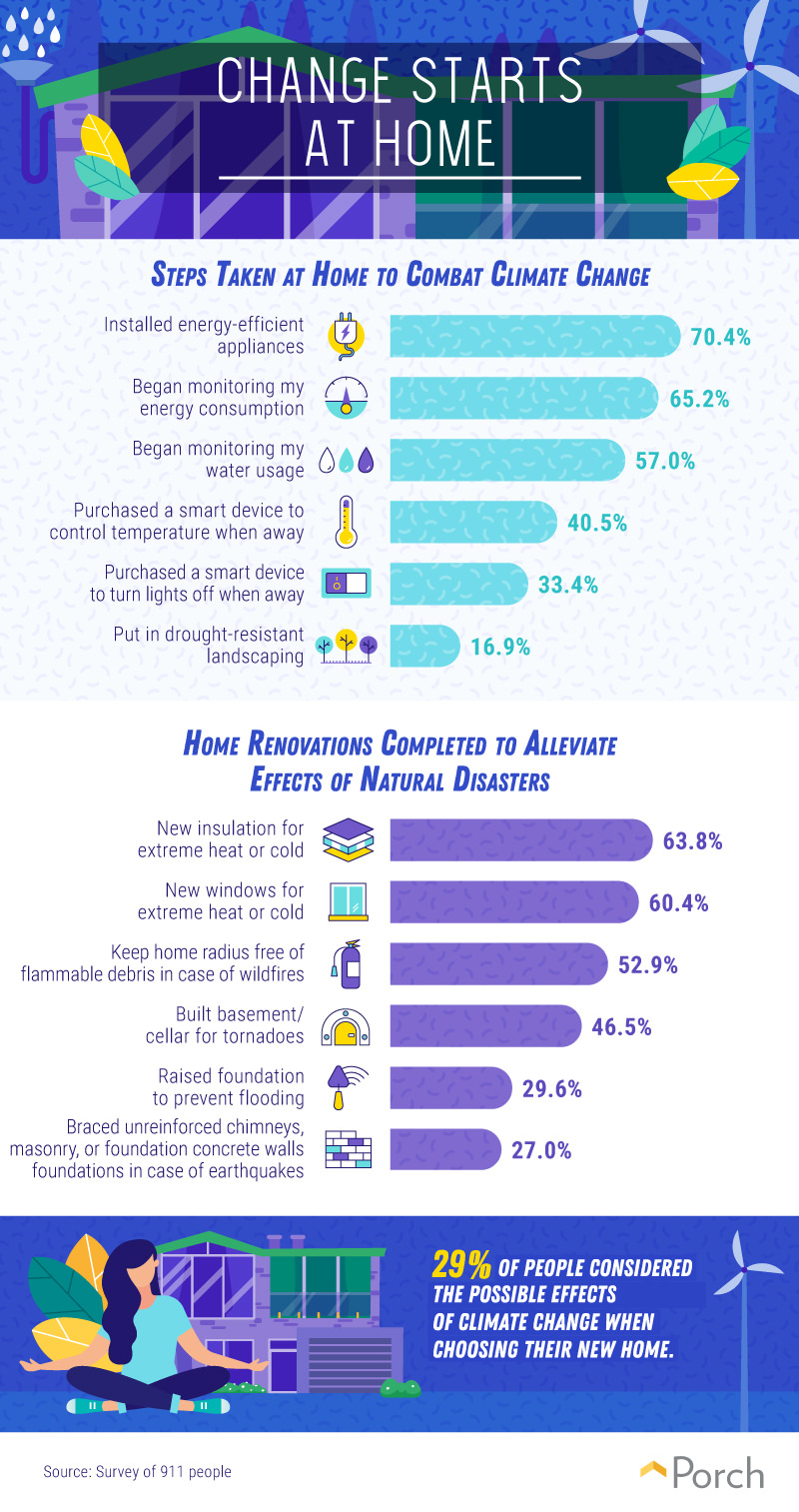
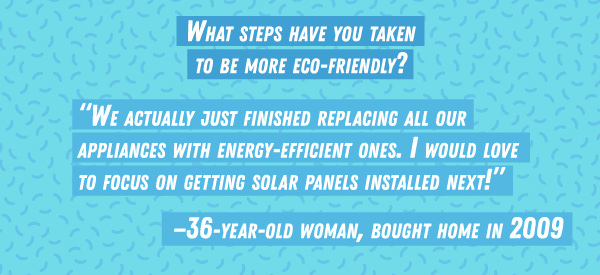
After decades of destructive behavior, experts suggest that even if the global population stopped emitting carbon dioxide entirely, there would be no returning to the temperatures of the past. Instead, we must look at how we can prevent climate change from worsening. Scientists theorize it would take at least 40 years to stabilize Earth’s surface temperature as it is today, and we must be vigilant in our efforts to reduce carbon emissions and other greenhouse gases. There may be no “magic bullet,” but sustainable efforts and renewable energy can have a positive impact on the environment.
Homeowners described making a variety of changes to their homes to protect against natural disasters triggered by existing climate change. Sixty-four percent of those surveyed renovated their home to include new insulation for extreme temperatures, followed by new windows for extreme temperatures (over 60 percent), and almost 53 percent eliminated flammable debris in case of wildfires. As the global surface temperature rises, moisture and precipitation levels will change too, increasing the likelihood that wildfires will burn longer and more intensely. The Camp Fire that burned through California in 2018 marked the deadliest fires in state history. It destroyed more than 6,400 homes and burned through over 2,800 square miles before being contained.
In addition to renovating their homes in response to natural disasters, homeowners also made efforts to combat climate change. Seventy percent of homeowners installed energy-efficient appliances, and more than half began monitoring their energy consumption and water usage.
New homebuying priorities
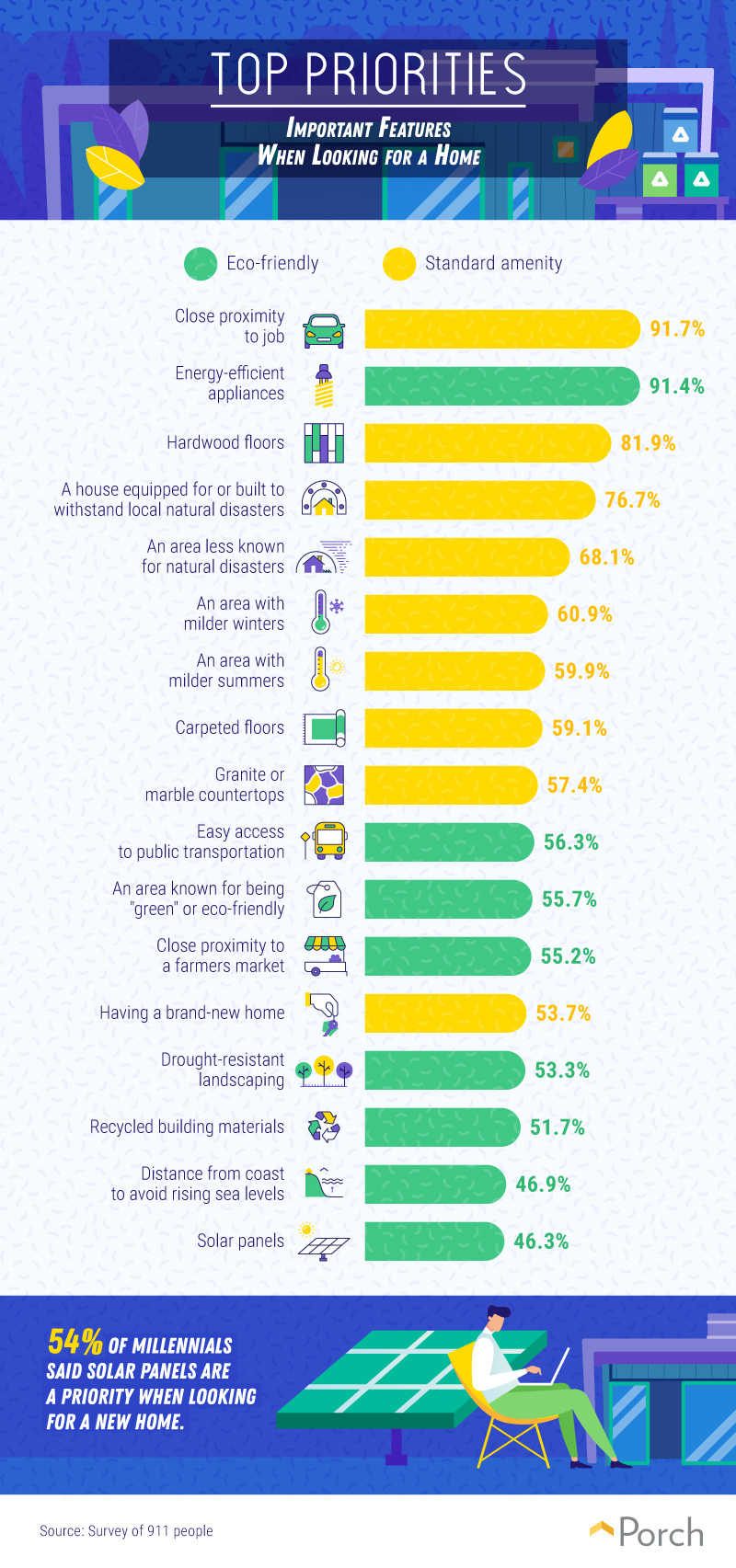
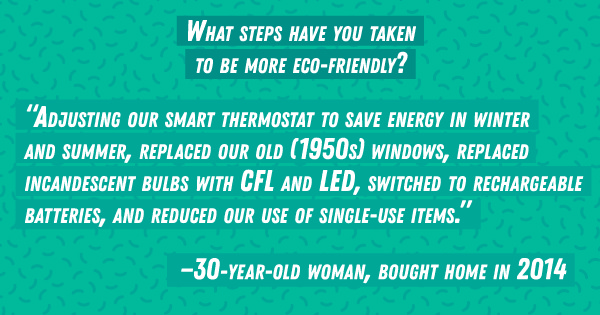
Homeowners considered close proximity to work (nearly 92 percent) and energy-efficient appliances (over 91 percent) to be important features when looking for a new home.
According to the U.S. Environmental Protection Agency, fewer miles driven means fewer emissions. Since spending less time behind the wheel can positively impact climate change and the environment, the EPA recommends taking public transit whenever possible, using ride-sharing services, and driving efficiently when there are no other viable forms of transportation. Studies show the number of “super commuters” continues to grow, and 1 in 36 commuters travel 90 minutes or more to work every day.
Other important features included hardwood floors (about 82 percent), homes built to withstand natural disasters (almost 77 percent), and homes in areas less known for natural disasters (68 percent). While solar power currently accounts for just 1 percent of the world’s electricity, studies show solar energy could grow by 6,500 percent by 2050. According to our survey, 54 percent of millennials identified solar panels as a priority when shopping for a new home.
Comparing commitment



Even small changes in energy consumption can have a positive impact on the environment and climate change. Using LED lightbulbs was the top action taken for a healthier climate, according to the homeowners polled. In 2010, conventional incandescent lightbulbs accounted for 68 percent of lighting in American homes. In 2016, conventional incandescent lightbulbs fell to just 6 percent of lights installed in homes, while LED lights rose to 14 percent. Studies show energy use has decreased in American homes, and lighting plays a major role in that shift. Not only do LEDs represent long-term savings for homeowners, but they also use 85 percent less energy than their traditional counterparts.
Homeowners also said they used reusable water bottles and recycled paper and plastic products. They were even willing to install solar panels, carpool to work, and purchase an electric vehicle. Experts suggest switching to electric vehicles could be one of the most important actions toward amending damage to the climate, with 60 percent of U.S. carbon pollution coming from power and transportation.
Homeowners drew the line at becoming vegan or vegetarian, using a shower timer, and bringing reusable straws to restaurants, however. Despite their hesitation, 77 percent believed banning single-use plastic bags would benefit the environment, and 67 percent of homeowners felt the same way about banning plastic straws.
Obligated to make a change
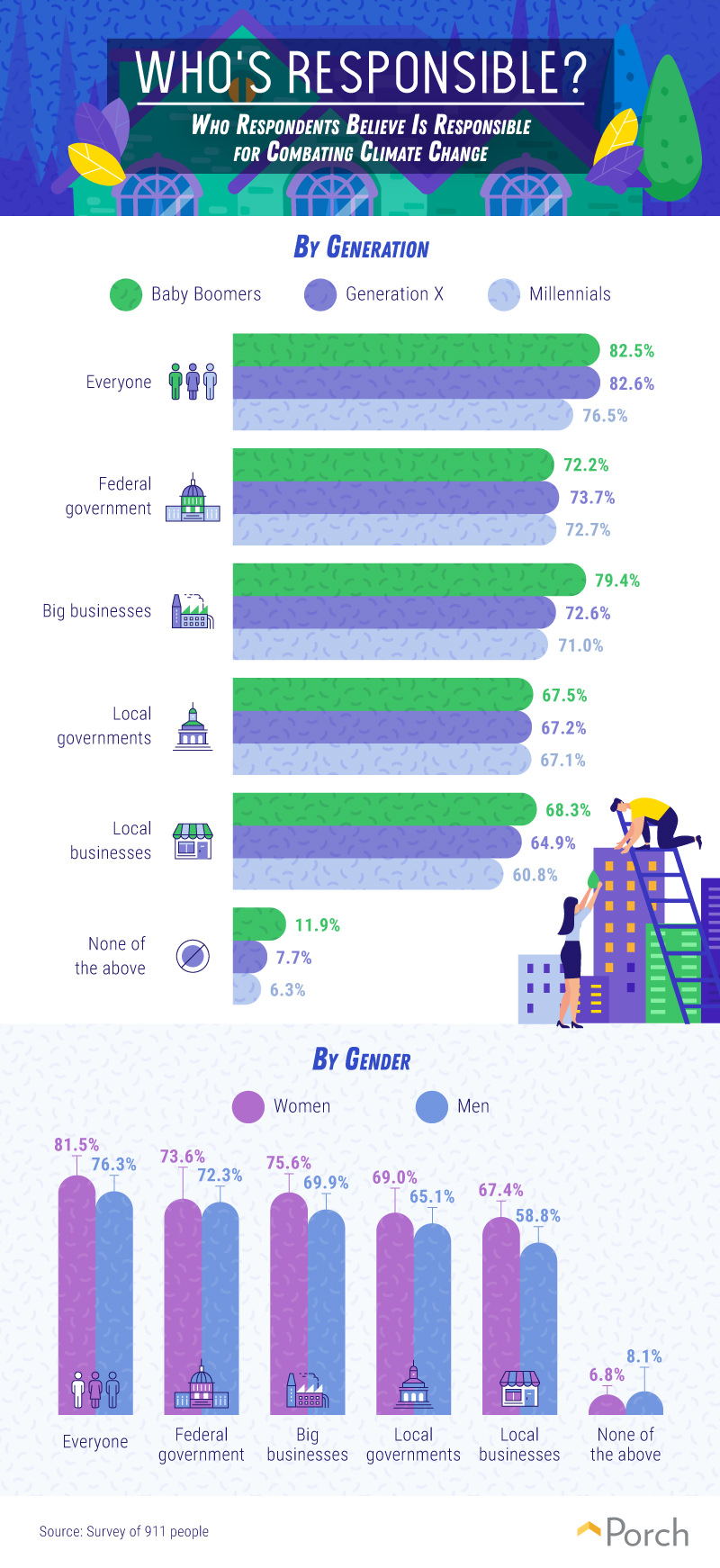
In 2019, the evidence supporting human-made climate change reached a “gold standard” of certainty. While the United Nations’ Intergovernmental Panel on Climate Change (IPCC) isn’t 100 percent certain that human activity has been the main cause of climate change this century, they concluded in 2013 that it was “extremely likely,” or 95 percent probable. In fact, the temperatures recorded between 2015 and 2018 were the hottest on record since the 19th century.
Homeowners agreed everyone was responsible for combating climate change. Including nearly 83 percent each of baby boomers and Gen Xers, almost 77 percent of millennials claimed responsibility for the current state of the planet. Led by older generations, homeowners also agreed the federal government, big businesses, and local municipalities were largely responsible for making changes to protect the environment and reduce the impact of climate change.
Claiming responsibility for our homes
While political posturing may suggest the scientific community and American population are conflicted about climate change, homeowners were of a different persuasion. A majority accepted NASA’s definition of climate change as being a human-made occurrence, and many believed they were more responsible than the government or big businesses to combat these devastating effects. In addition to installing energy-efficient appliances, lightbulbs, and recycling, homeowners were willing to install solar panels and carpool to reduce their impact on the environment.
At Porch, we’ll help make it easy to convert your home into an environmentally friendly oasis. Whether you’re thinking about installing new, energy-efficient appliances, weather-resistant windows or doors, new insulation, or something else entirely, we’ve got the professionals you need to get the job done. With our Porch Home Assistant, we’ll match you with certified experts in your area who specialize in whatever’s lingering on your to-do list. Visit us at Porch to learn more.
Methodology and limitations
To gather the data presented above, a survey was ran using Amazon’s Mechanical Turk service. 911 people were surveyed, and respondents had to be current homeowners to qualify for the survey. Of those surveyed, 444 were female, 466 were male, and one person chose to identify as neither. 129 of the respondents were baby boomers, 266 were from Generation X, 512 were millennials, and four fell into generations outside those.
The data presented in the study rely on self-reporting, which can be host to a number of issues, including telescoping and exaggeration. To ensure the most accurate answers possible were achieved, attention checks were used in the survey.
Sources
- https://www.nytimes.com/2019/02/16/opinion/sunday/fear-panic-climate-change-warming.html
- https://www.nytimes.com/interactive/2018/10/07/climate/ipcc-report-half-degree.html
- https://www.theguardian.com/environment/climate-consensus-97-per-cent/2018/oct/22/trump-thinks-scientists-are-split-on-climate-change-so-do-most-americans
- https://www.eenews.net/stories/1060123363
- https://theconversation.com/if-we-stopped-emitting-greenhouse-gases-right-now-would-we-stop-climate-change-78882
- https://www.ucsusa.org/global-warming/science-and-impacts/impacts/global-warming-and-wildfire.html
- https://www.nytimes.com/2018/11/12/us/california-fires-camp-fire.html
- https://www.epa.gov/transportation-air-pollution-and-climate-change/what-you-can-do-reduce-pollution-vehicles-and-engines
- https://www.cnbc.com/2018/08/20/pr-rep-commutes-4-hours-every-day-to-avoid-45000-dollar-san-francisco-rent.html
- https://www.fool.com/investing/2018/10/14/can-solar-energy-really-grow-6500-by-2050.aspx
- https://www.nytimes.com/interactive/2019/03/08/climate/light-bulb-efficiency.html
- https://www.theguardian.com/environment/climate-consensus-97-per-cent/2018/jan/22/switching-to-electric-cars-is-key-to-fixing-americas-critically-insufficient-climate-policies
- https://www.reuters.com/article/us-climatechange-temperatures/evidence-for-man-made-global-warming-hits-gold-standard-scientists-idUSKCN1QE1ZU
Fair use statement
We can’t completely undo the impact of climate change, but we can make efforts to prevent further damage. Share the ideas and suggestions presented in our study with your readers for any noncommercial use as long as you include a link back to this page in your story.
